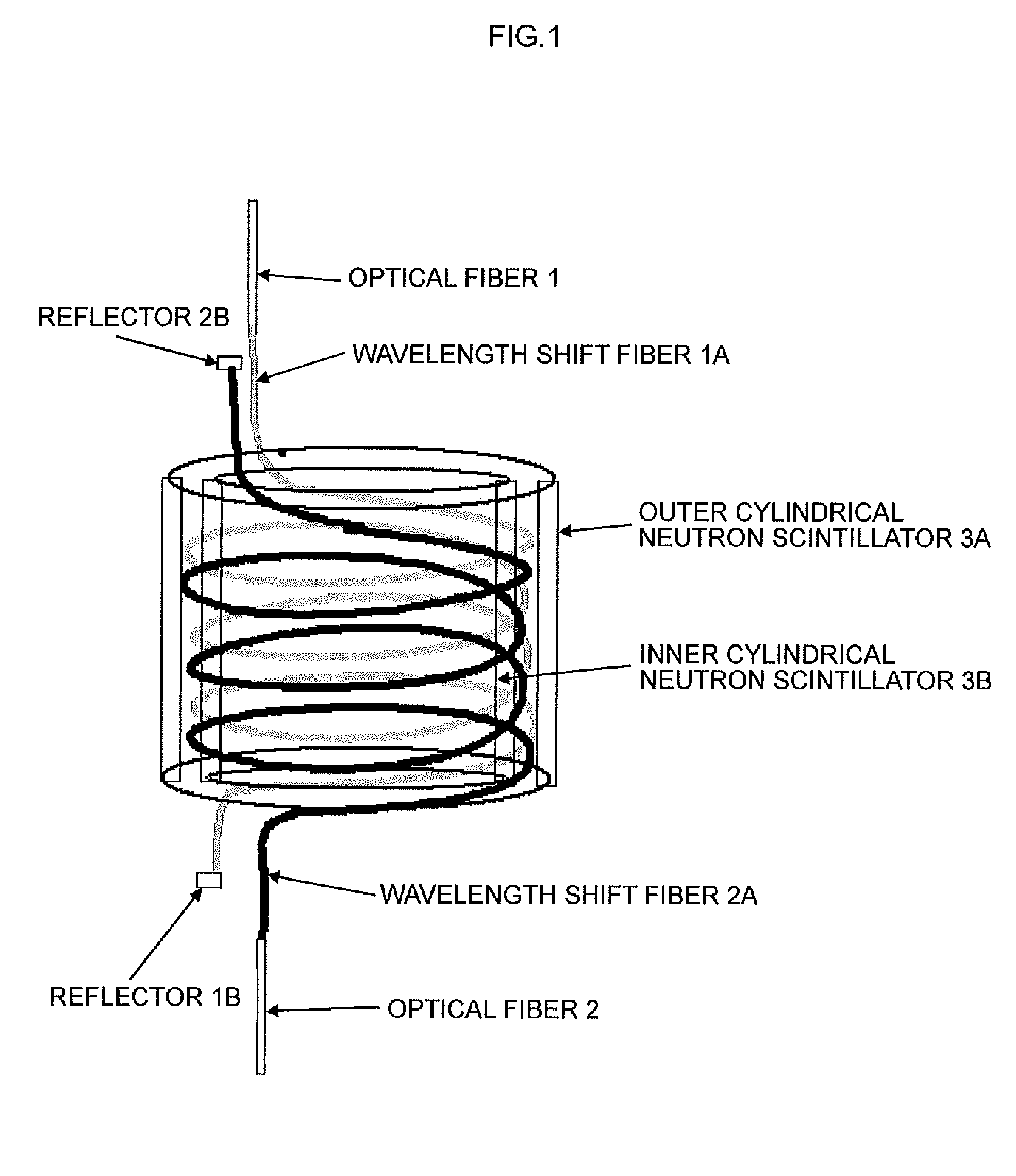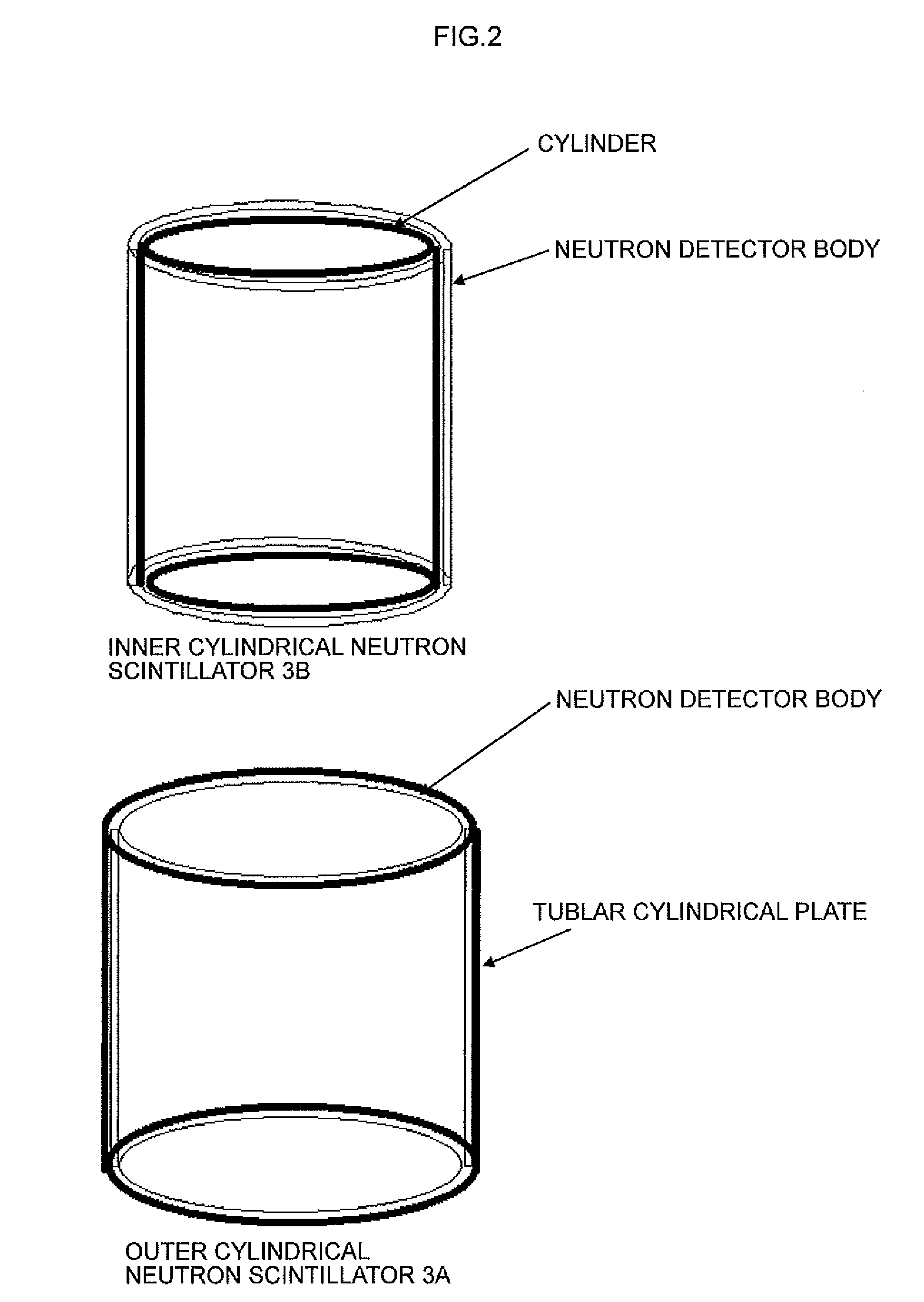Neutron detector
a neutron detector and detector technology, applied in the field of neutron detectors, can solve the problems of difficult to obtain sup>3, difficult to use it as a neutron image detector, and inferior neutron detection efficiency, so as to improve the neutron detection efficiency, improve the sensitivity of zns to the gamma ray, and achieve high detection efficiency.
- Summary
- Abstract
- Description
- Claims
- Application Information
AI Technical Summary
Benefits of technology
Problems solved by technology
Method used
Image
Examples
embodiment 1
(Embodiment 1)
[0041]Embodiment 1 of the present invention will be explained referring to FIG. 1. FIG. 1 shows schematically the structure of the neutron detecting element used in the neutron detector according to Embodiment 1. This neutron detecting element comprises
[0042]an inner cylindrical neutron scintillator where a neutron detection body which includes a ZnS phosphor and a 6LiF neutron converter material is arranged outside of the cylindrical substrate; a scintillator fluorescence detection body made by placing coiled wavelength shift fibers where two wavelength shift fibers (1a, 2a) are wound in parallel along the cylindrical substrate over an inner cylindrical neutron scintillator, leading both terminals of the two wavelength shift fibers (1a, 2a) inside the cylindrical substrate of inner cylindrical neutron scintillator 3b, and bonding light reflectors (1b, 2b) after optical fibers (1, 2) which lead fluorescence of which the wavelength was shifted in the wavelength shift fi...
embodiment 2
(Embodiment 2)
[0066]Next, the neutron detector of other types is explained referring to FIG. 8. 32 neutron detecting elements are closely arranged in the cylinder for neutron detecting element arrangement. The space in the cylinder of the neutron detecting element is used as a conduit for optical fibers. Two optical fibers are led to two optical detectors, respectively, arranged on both sides of the cylinder for neutron detecting element arrangement. After the optical fibers which led out from each neutron detecting element is settled as a pair to form two set of optical fiber bunches, each fluorescence is detected by two optical detectors. The fluorescence signals converted into pulse signals by two optical detectors are led to a coincidence circuit. When two fluorescence signals are measured simultaneously during the predetermined period of time, a neutron signal is output.
[0067]When the high position resolution is not required, longer element is advantageous in the cost. Therefor...
embodiment 3
(Embodiment 3)
[0082]The neutron detector which performs one-dimensional detection of neutrons is explained based on Embodiment 3. 28 neutron detecting elements according to Embodiment 1 are arranged in close proximity to each other in the cylinder for neutron detecting element arrangement. Where, each neutron detecting element serve as a one-dimensional position detection body. The space in the cylinder of the neutron detecting element is used as a conduit for optical fibers. Two optical fibers are led to a multichannel optical detector, arranged on one side of the cylinder for neutron detecting element arrangement. Each fluorescence is detected by two optical detectors, using the optical fibers which led out from each neutron detecting element as a pair. The fluorescence signals converted into pulse signals by two optical detectors are led to a coincidence circuit. When two fluorescence signals are measured simultaneously during the predetermined period of time, a neutron signal is...
PUM
 Login to View More
Login to View More Abstract
Description
Claims
Application Information
 Login to View More
Login to View More - R&D
- Intellectual Property
- Life Sciences
- Materials
- Tech Scout
- Unparalleled Data Quality
- Higher Quality Content
- 60% Fewer Hallucinations
Browse by: Latest US Patents, China's latest patents, Technical Efficacy Thesaurus, Application Domain, Technology Topic, Popular Technical Reports.
© 2025 PatSnap. All rights reserved.Legal|Privacy policy|Modern Slavery Act Transparency Statement|Sitemap|About US| Contact US: help@patsnap.com



